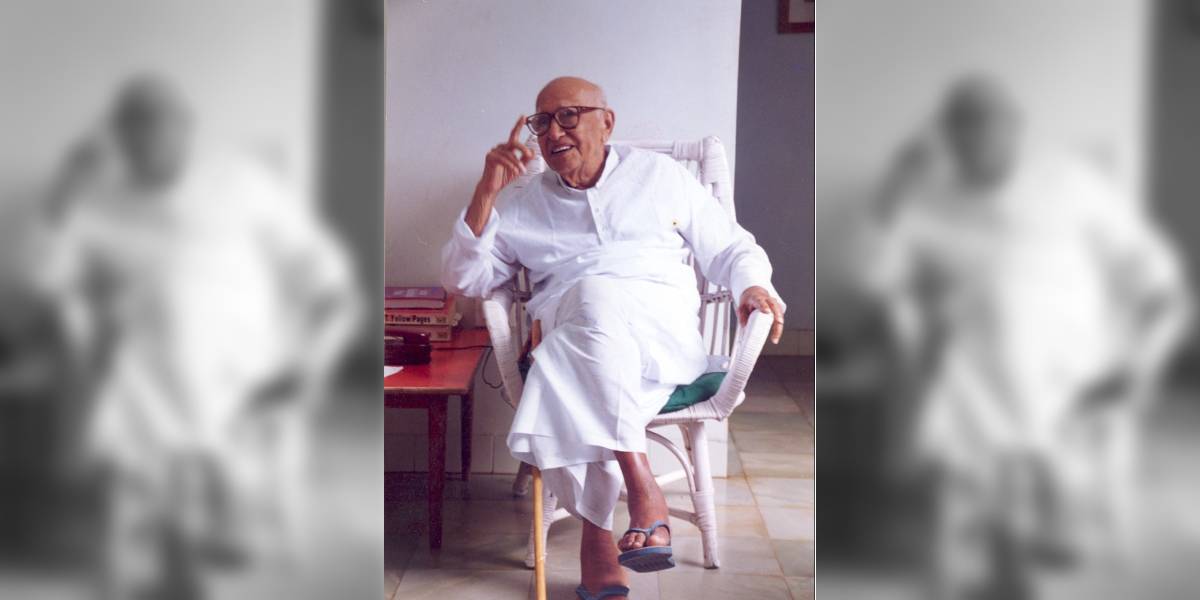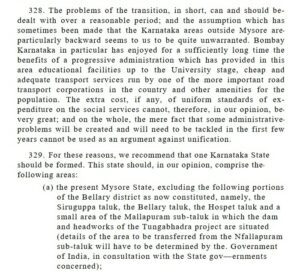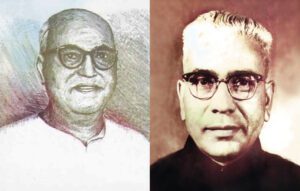Today is the 120th birth anniversary of the former chief minister, who fought for unification regardless of the consequences of antagonising Jawaharlal Nehru.

S Nijalingappa, first chief minister of a unified Kannada state (Nijalingappa Trust)
Tension is mounting once again along the Karnataka-Maharashtra border.
Maharashtra claims parts of Karnataka’s Belagavi district on linguistic grounds. The border dispute spanning more than 60 years has returned to haunt both states because of political reasons.
The Maharashtra government had challenged some provisions of the State Reorganisation Act, 1956, in the apex court. The Act was based on the findings of the Justice Fazal Ali Commission, which was appointed in 1953 and submitted its report two years later. The BJP, which is driving both the Maharashtra and Karnataka governments, from back and front respectively, is trying to harvest political mileage amidst this linguistic fury.
At this juncture, the 120th birth anniversary of Siddavanahalli Nijalingappa, the first chief minister of unified Karnataka and the first Kannadiga to head the All India Congress Committee (AICC), will pass through unnoticed.
S Nijalingappa was born to a middle-class family in Halavagalu village in the present-day Ballari district of Karnataka on 10 December 1902. ‘SN’, as he is fondly and respectfully referred to by the people in Karnataka, is still remembered for his contribution to the cause of the unification of Karnataka.
Browsing the pages of Indian pre-and post-Independence history, one will notice an important phase in the reorganisation of states. When it comes to the question of Karnataka, Mahatma Gandhi made it clear that unification was inevitable in 1938.
Sardar Vallabhbhai Patel, who attended the meeting of the Unification Council held in Bombay in 1946, favoured the formation of linguistic states in the federal structure of the new government to be formed after Independence.
Nijalingappa, who argued for the unification of Karnataka, fought for the cause regardless of the consequences of antagonising Jawaharlal Nehru, one of the tallest leaders of the Congress.
Succumbing to the pressure for reorganisation, the Union government constituted a commission chaired by SK Dhar to investigate the feasibility of organising states on a linguistic basis in 1948.
The Dhar Commission opined that Karnataka was not prepared for unification. This resulted in a lot of resentment among Congressmen in Karnataka, especially SN, who was heading the Congress in the state.
Understanding the seriousness of the issue, the Centre formed another three-member committee, comprising the then prime minister Jawaharlal Nehru, Union minister for home Sardar Vallabhbhai Patel, and Pattabhi Seetharamaiah. Unfortunately, the three-member committee reiterated and upheld the opinion of the Dhar Commission. It had become a kind of ‘test of fire’ for Nijalingappa.
In the first general election held in 1951, the Congress came to power by making the unification of Karnataka its agenda. Nijalingappa conveyed the seriousness of the issue to Sardar Patel, as Nehru was not in a mood to listen to him.
Finally, The States Reorganisation Commission constituted by the Central government headed by Justice Fazal Ali started assessing the need to unify Karnataka.
Based on the report submitted by the Commission, Kannada-speaking areas, which were spread across four neighbouring states, were brought under what was known as Mysore State on 1 November 1956.
The then President of India Rajendra Prasad himself came to Bangalore because of his association with Nijalingappa and announced the formation of a new unified Kannada state. The region was later renamed Karnataka during the regime of Devaraj Urs in 1973.

The Fazal Commission in 1955 recommend the transfer of four Kannada-speaking districts in the then Bombay State to Karnataka
S Nijalingappa died on 8 August 2000 at the age of 97. His integrity had made him a towering personality in the political history of India and Karnataka.
His demise marked the end of an era of ethical, moral, and value-based politics in India. There is now a generation of value-less, self-centred, and power-hungry politicians — and their heirs now waiting in the wings to continue dynastic politics.
Nijalingappa was the embodiment of the virtue of simplicity. Never did he favour the culture of dynastic politics. His sons and daughters continue to lead normal lives.
An incident recounted by Shankar Bidari, former director general and inspector general of police, Karnataka, in his autobiography Satyameva Jayate testifies to SN’s way of simple living.
Ramakrishna Hegde, the first non-Congress politician to rise to the post of chief minister in the political history of Karnataka, went abroad for medical treatment in his second term in power as CM. He wished to talk to his political mentor, guide, and philosopher SN.
When Hegde dialled Nijalingappa, the response from the other side was “this number doesn’t exist”.
After making several attempts, Hegde directed his personal secretary Ramappa to find out what was wrong with his guru’s landline number. Ramappa contacted Shankar Bidari, then superintendent of police, Chitradurga. Interestingly, Shankar Bidari served in the Department of Telecommunication before joining the Indian Police Service.
Bidari sensed that the telephone connection of the former chief minister was disconnected for non-payment. The pending bill was a meagre ₹40 at that time. He got the phone reconnected by paying ₹65 (including the reconnection fee of ₹25).
When his phone started ringing, Nijalingappa was surprised, as he knew that his phone had been disconnected for non-payment. When he enquired, he learned that it was the SP of Chitradurga who paid the bill and got the phone reconnected. He called Bidari to his house and served him his favourite filter coffee and requested him to come again in the first week of next month without fail.
This is because the two-time CM of Karnataka had no money to pay the telephone bill and had to wait for his monthly pension to return the money to Bidari. When Bidari visited Nijalingappa’s house for the second time, the former CM handed over ₹65 and thanked him profusely.
Politicians of the present generation refuse to vacate their official residence even after the expiry of their term in office and continue to enjoy all official benefits even after demitting it.
But SN — a Gandhian, freedom fighter, first chief minister of a united Mysore State, and president of Indian National Congress at the time of its epochal split in 1969 and besides that a statesman with a difference — declined the offer of free government accommodation in Bengaluru after his wife passed away in 1989 and moved to his own house in Chitradurga, which he had built in 1932 with his earnings as a practising advocate.
Former Karnataka chief minister Ramakrishna Hegde once described Nijalingappa as a leader of an era when politics was imbued with the ideal and passion of the freedom struggle and a galaxy of visionaries shaped the destiny of India. SN’s life also spanned the last quarter of the twentieth century when in striking contrast, self-centeredness took the political centre stage.
During a conversation with this writer in the late 90s, Nijalingappa narrated an incident that explains his humble way of living in Chitradurga in the evening of his life.
The then president of the All India Congress Committee (AICC) Sonia Gandhi showed an interest in meeting Nijalingappa. To follow the protocol, security staff visited his house, just for customary clearance.
Nijalingappa told the security staff that “only 11 members can accompany Sonia Gandhi, as I have just a dozen cups and saucers and cannot afford more”. Sonia Gandhi respected and honoured the pre-condition set by him.
SN’s Diary brought out by the S Nijalingappa National Trust on the occasion of the former chief minister’s birth centenary reveals that he refused a salary of ₹10,000 a month in 1959 and allowances as chairman of Indian Oil Corporation. He preferred a token salary of just one rupee.
“He did not own a car and people who knew him would always rush to his help. Whenever I have invited him to a Kannada-related function, he would humbly ask for a taxi service,” recalls Kannada writer and social activist, Ra.Nam. Chandrashekar to South First. Such was the lifestyle of Nijalingappa. In that sense, he was a true socialist.
The general secretary of the Sardar Vallabhbhai Patel Trust, Dr Chopra, wrote to the then President of India KR Narayanan in 1997 requesting him to consider Nijalingappa’s name for the Bharat Ratna — the highest civilian award of the Republic of India.
On learning about it, Nijalingappa penned a detailed letter to President Narayanan, appealing to him not to consider his name for Bharat Ratna.
Surprised by the former chief minister’s humility, KR Narayanan reacted in his letter that the “highest human values are still intact in the country, just because of personalities like Nijalingappa”. These three letters are still available with the Nijalingappa Trust.
In India and especially in Karnataka, caste is the criterion to grow in politics and to become the chief minister.
A Lingayat, Nijalingappa suggested that the CM post go to Ramakrishna Hegde, a Brahmin, as his successor when he was asked to become Congress president.
“Both Ramakrishna Hegde and Veerendra Patil were his lieutenants and were fondly referred to as ‘Lava-Kusha’. But Hegde refused as there were more Lingayats in Nijalingappa’s Cabinet and they might not accept him (Hegde) as chief minister. Inevitably, Nijalingappa opted for Veerendra Patil,” veteran journalist and political analyst MK Bhaskar Rao tells South First.
When Ramakrishna Hegde led the Janata Party-led government in Karnataka, Nijalingappa was associated with that party. But Nijalingappa resigned from the Janata Party as he understood that its leaders were also morally corrupt. SN asked Hegde, “How could I ask people to exercise their franchise for Janata when communalism and casteism are rampant in the party?”
A glance through the Karnataka Rajakiya Chintane S Nijalingappa Janma Shatamanotsava Samsmarane, an 820-page volume by S Nijalingappa National Trust, offers numerous incidents of this kind that shows his transparency, humility, and democratic instincts — all of which made him a leader of exceptional stature.
SN lost his father when he was just five and studied in Chitradurga, Bengaluru, and Pune.
Annie Besant’s writings inspired him to join politics. SN took an active role in the freedom struggle and established the Congress in the then Mysore State in the 1930s. He was imprisoned and lost his licence to practise law.
He then became an ardent follower of Mahatma Gandhi in the Quit India Movement. When India became independent, Nijalingappa became a member of the Constituent Assembly and later an MP.
When the unified Kannada state was formed in 1956, he became its first chief minister. Two years later, he was replaced by BD Jatti, because of an internal dispute within the Congress and for antagonising party supremo Jawaharlal Nehru during unification.
However, Nijalingappa was back as chief minister in 1962. “Unlike the present-day chief minister [SM Krishna was then CM of Karnataka], Nijalingappa completely focused on rural development, much against the wishes of Jawaharlal Nehru,” says noted journalist Mahadeva Prakash in his Horalu Daari.

In 1966, with the consent of S Nijalingappa (L) and Vasantrao Naik, the then chief ministers of Karnataka and Maharashtra respectively, the then PM Indira Gandhi constituted a second commission under former chief justice Mehr Chand Mahajan to resolve the Karnataka-Maharashtra border dispute (Wikimedia Commons/DGIPR Maharashtra website)
Later, Indira Gandhi invited Nijalingappa to Delhi and made him president of the Indian National Congress.
But Nijalingappa regretted having accepted the offer. His period as Congress president was stormy. The relationship with Indira Gandhi, which was cordial earlier, later turned antagonistic.
In the great Congress split of 1969, Nijalingappa formed the splinter Indian National Congress (Original) and became its president. In the 1971 general elections, the INC(O) lost miserably by gaining only 16 seats as against 352 seats of the Indira Congress.
It was during Nijalingappa’s time as chief minister that the River Cauvery was tapped for Bengaluru and the Sharavathi Hydro-Electric scheme was completed.
Six irrigation projects were launched and an old-age pension scheme was introduced. During his last days, Nijalingappa looked most satisfied with what he managed to do for the people during his tenure as CM.
Nijalingappa can be called the architect of modern Karnataka. The state owes much to him for the development of agriculture, irrigation, and industrial and transport projects.
Another landmark achievement of Nijalingappa is offering shelter to thousands of Tibetan refugees in the state in 1959. Karnataka today has some of the largest Tibetan settlements — Bylakuppe, Mundgod, Kollegal, and Gurupura.
When Somappa Rayappa Bommai, father of the present chief minister Basavaraj Bommai, headed the state in 1988, he offered to help Nijalingappa by allotting a house and special medical treatment.
But Nijalingappa, who never compromised with his self-esteem, rejected the offer. When he suffered a fracture prior to his death in August 2000, he insisted on getting admitted to the government-owned Bowring and Lady Curzon Hospital in Bengaluru and politely declined the offer of free treatment in a private super speciality hospital made by the then chief minister SM Krishna.
The Karnataka government celebrated the birth centenary of Nijalingappa in a meaningful manner in 2002, unveiling a statue of the architect of Karnataka at the West-entry of Vidhana Soudha, besides publishing three volumes on the life and contribution of Nijalingappa to Kannada and Karnataka.
(Muralidhara Khajane is a senior journalist, writer, and film critic. He is the author of ‘Random Reflections: A Kaleidoscopic Musings on Kannada Cinema’)

Apr 26, 2024

Apr 26, 2024

Apr 26, 2024

Apr 26, 2024

Apr 26, 2024

Apr 26, 2024